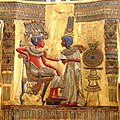Grave goods
Grave goods or funerary objects are items buried with a corpse in graves or tombs, intended to accompany the deceased in the afterlife or to protect the dead in the journey to the afterlife. Grave goods can be seen in many cultures and civilizations throughout history, from the ancient Egyptians to the Vikings.
History[edit | edit source]
The practice of burying grave goods with the deceased dates back to the Neolithic Age, when people began to bury their dead with items such as pottery and stone tools. This practice continued into the Bronze Age and Iron Age, with the addition of weapons, jewelry, and other valuable items.
In the ancient Egyptian civilization, grave goods were an important part of the burial process. The Egyptians believed that the deceased would need these items in the afterlife, and so they were buried with a variety of goods, including food, clothing, and amulets.
The Vikings also buried their dead with grave goods, often including weapons, tools, and personal items. These goods were believed to accompany the deceased in the afterlife.
Types of Grave Goods[edit | edit source]
There are many different types of grave goods, depending on the culture and time period. These can include:
- Pottery: This is one of the most common types of grave goods, found in many different cultures and time periods. Pottery can include bowls, jars, and other vessels, often containing food or drink for the deceased.
- Jewelry: Jewelry is often found in graves, especially in cultures where wealth and status were important. This can include rings, necklaces, bracelets, and other items made from precious metals and gemstones.
- Weapons: In some cultures, especially warrior cultures, weapons are a common type of grave good. These can include swords, spears, axes, and other weapons.
- Clothing: Clothing is often found in graves, either worn by the deceased or placed in the grave as a separate item. This can include everyday clothing, as well as special burial garments.
Significance[edit | edit source]
The significance of grave goods can vary greatly, depending on the culture and time period. In some cultures, grave goods are seen as necessary items for the afterlife, while in others they are seen as a way to honor the deceased or to show their status in life.
Grave goods can also provide valuable information for archaeologists and historians, helping to shed light on the beliefs, customs, and lifestyles of past cultures.
See Also[edit | edit source]
Search WikiMD
Ad.Tired of being Overweight? Try W8MD's physician weight loss program.
Semaglutide (Ozempic / Wegovy and Tirzepatide (Mounjaro / Zepbound) available.
Advertise on WikiMD
|
WikiMD's Wellness Encyclopedia |
| Let Food Be Thy Medicine Medicine Thy Food - Hippocrates |
Translate this page: - East Asian
中文,
日本,
한국어,
South Asian
हिन्दी,
தமிழ்,
తెలుగు,
Urdu,
ಕನ್ನಡ,
Southeast Asian
Indonesian,
Vietnamese,
Thai,
မြန်မာဘာသာ,
বাংলা
European
español,
Deutsch,
français,
Greek,
português do Brasil,
polski,
română,
русский,
Nederlands,
norsk,
svenska,
suomi,
Italian
Middle Eastern & African
عربى,
Turkish,
Persian,
Hebrew,
Afrikaans,
isiZulu,
Kiswahili,
Other
Bulgarian,
Hungarian,
Czech,
Swedish,
മലയാളം,
मराठी,
ਪੰਜਾਬੀ,
ગુજરાતી,
Portuguese,
Ukrainian
Medical Disclaimer: WikiMD is not a substitute for professional medical advice. The information on WikiMD is provided as an information resource only, may be incorrect, outdated or misleading, and is not to be used or relied on for any diagnostic or treatment purposes. Please consult your health care provider before making any healthcare decisions or for guidance about a specific medical condition. WikiMD expressly disclaims responsibility, and shall have no liability, for any damages, loss, injury, or liability whatsoever suffered as a result of your reliance on the information contained in this site. By visiting this site you agree to the foregoing terms and conditions, which may from time to time be changed or supplemented by WikiMD. If you do not agree to the foregoing terms and conditions, you should not enter or use this site. See full disclaimer.
Credits:Most images are courtesy of Wikimedia commons, and templates, categories Wikipedia, licensed under CC BY SA or similar.
Contributors: Prab R. Tumpati, MD




